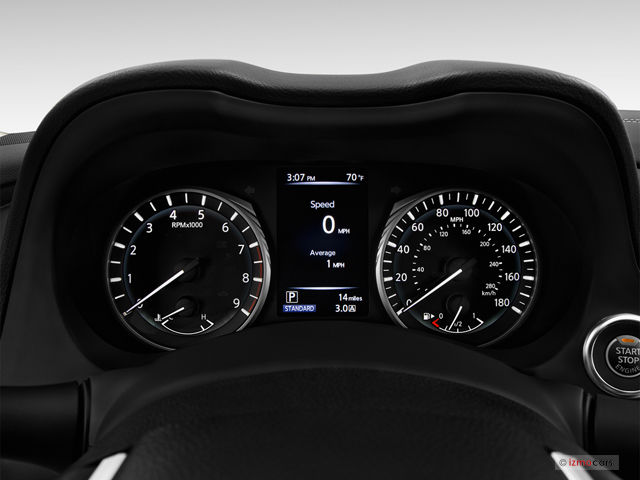The Infiniti Q50 assists in monitoring and controlling the vehicle’s stability, traction, suspension, and other chassis functions. One problem message that owners may occasionally see is related to the vehicle’s chassis control system. What are reasons for chassis control system error Infiniti Q50?
The chassis control system includes electronic stability control, traction control, adaptive suspension dampers, and other components. An issue in the chassis control system indicates that one or more of these components is not functioning properly. Some common causes include worn or malfunctioning suspension components, problems with sensors that provide feedback to the electronic control unit, and issues with the control unit itself.
When this issue happens, the vehicle’s handling may become unstable, as well as its traction on varied road surfaces. To guarantee safe and dependable vehicle performance, you should identify and address the root cause of the chassis control system error code.

Contents
Reasons For Chassis Control System Error Infiniti Q50?
Here are some more specific causes of a chassis control system fault in an Infiniti Q50:
Worn shock absorbers/struts
As the dampers age, they lose their ability to manage wheel bounce and vehicle motion. This can result in inaccurate sensor readings.
Bad ball joints/control arms
Wear and tear on front end components such as ball joints and control arms can cause suspension geometry to deviate from factory standards. Sensors may detect anomalies.
Bushing deterioration
The bushings that connect the suspension and steering components wear down over time, causing play in the linkages. This changes how the vehicle handles.
Tire imbalance or uneven wear
Problems with one or more tires, such as a broken belt inside or an uneven wear pattern, might cause traction control functions to fail.
Low/contaminated brake fluid
To function properly, the stability control system relies on brake lines and wheel speed sensors. Low or filthy fluid levels might have an effect on system performance.
Damaged wheel bearings
Faulty wheel bearings create uneven wheel rotation, which confuses ABS and traction control systems. The ABS pump or module is critical in managing braking pressure. A failure in one of these components can result in a Chassis Control System fault.
Steering rack/linkage faults
Problems with the steering and linkage system, such as a worn rack, can lead to inadequate communication between components.
Faulty wheel speed sensors
Corrosion, physical deterioration, or electrical flaws within the sensors interfere with accurate speed input readings.
Rusted or corroded electrical connections
Connectors beneath the vehicle gather moisture and dirt with time, limiting signal transmission.
Mechanical Issues
Mechanical components, such as the steering system or suspension, might have an indirect impact on the Chassis Control System.

How To Fix Chassis Control System Error Infiniti Q50?
Here are some general steps you can take to address the problem:
Check for Visible Issues
Examine the wiring and connectors associated with the Chassis Control System for evident damage or loose connections. Check for contamination, damage, or misalignment of the wheel speed sensors.
Perform a Diagnostic Scan
To extract fault codes from the Chassis Control System, use an OBD-II diagnostic scanner. These codes can provide information about the individual component or system that is failing.
Address Sensor Issues
If the diagnostic scan reveals a sensor issue, consider replacing the faulty sensor. Check that the sensors are properly aligned and free of debris.
Inspect ABS Pump and Module
Examine the ABS pump and module for any evident problems. Repair or replace if there are symptoms of damage or malfunction.
Resetting the System
A system reset may clear transient issues in some instances. This can be accomplished by briefly removing and reconnecting the vehicle’s battery.
Professional Inspection
If the problem persists, take your car to a skilled automotive mechanic or dealership. To diagnose and repair mechanical systems, technicians use specialized instruments and knowledge.
Can I Drive My Infiniti Q50 With Chassis Control System Error?
NO, YOU CAN’T.
It depends on a few criteria if you can drive your Infiniti Q50 with a chassis control system error:
- Severity of the error: A minor flaw may only affect particular functionalities, whereas a major flaw may compromise safety systems.
- Other lighted warning lights: Adding more illuminated warning lights might make driving less safe.
- Driving conditions: Avoid driving in inclement weather or heavy traffic until the problem is rectified.
- Underlying issue: A faulty component, such as faulty wheel sensors, could be hazardous.
YES, YOU CAN.
In general, ignoring a chassis control system malfunction for an extended period of time is not recommended. It covers systems that are critical for stability and handling. However, in rare instances, restricted driving may be permissible if:
- It’s merely a little glitch that keeps all functionality operational.
- Aside from the chassis code, no additional warning lights are illuminated.
- You drive gently, avoid risks, and get it checked out as quickly as possible.
As quickly as possible, have a mechanic diagnose the situation. Some faults may cause traction control, ABS, and other systems to delay or fail. Play it safe until you have confirmed that it is low-risk. Before traveling long distances or at high speeds, major flaws should be repaired.